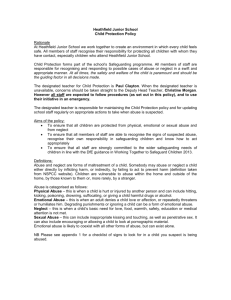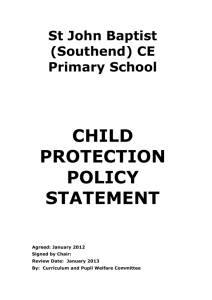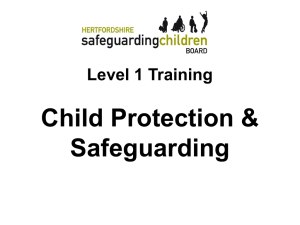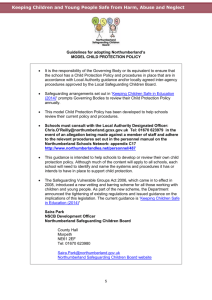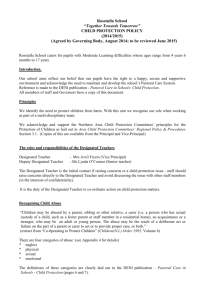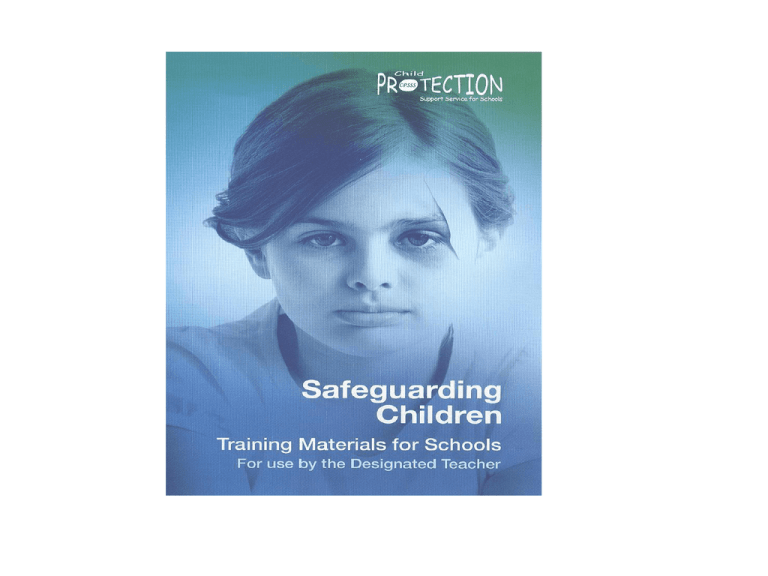
Aim and Learning Objectives
The aim of this training session is to raise awareness of child protection
and safeguarding in your school.
By the end of this training session you will:
• Have an understanding of your school’s policy/ in /procedures
relation to safeguarding/child protection
• Be able to identify the signs and symptoms of abuse
• Know what to do if you have safeguarding or child protection
concerns
• Have an understanding of the roles and responsibilities of key
people in your school in relation to safeguarding and child protection
Introduction: a Cause for Concern
What would you do in the situation of the school meals’ supervisor?
What would you do next in the case of the crossing patrol person?
If you later learned that the child in the corridor often did this, and some
colleagues thought it simply a means of getting attention, would you
act differently?
If you learned that the child who asked for more dinner often did this,
but invariably never ate the food, would you act differently?
Your School’s Policy
Your school’s policy states:
• The importance of the child;
• The school’s understanding of what constitutes abuse;
• What to do if you think a child may be a victim of abuse;
• The names of the Designated Teacher and the Deputy Designated
Teacher with responsibility for child protection; and
• What to do in the absence of the Designated Teacher.
Your School’s Policy
Are you familiar with your school’s policy?
Are you confident that you know how to act and
when?
Are you familiar with what constitutes abuse?
Do you know who the Designated and Deputy
Designated Teacher in your school is?
Signs and Symptoms
Child abuse means ill treatment or neglect leading to
physical, sexual or emotional injury or harm.
The following illustrations outline common indicators of
abuse and neglect.
These signs are not a checklist, indeed many of them could
have other explanations.
Signs and Symptoms
Physical Abuse – Physical Indicators
• Unexplained bruises or burns particularly if they are
recurrent
• Human bite marks, welts or bald spots
• Unexplained lacerations, fractures or abrasions
• Untreated injuries
Signs and Symptoms
Physical Abuse – Behavioural Indicators
•
Self-destructive behaviours
•
Improbable excuses given to explain injuries
•
Chronic runaway
•
Aggressive or withdrawn
•
Fear of returning home
•
Reluctant to have physical contact
•
Clothing inappropriate to weather – worn to hide part of the body
Signs and Symptoms
Neglect – Physical Indicators
• Constant hunger
• Poor state of clothing and/or personal hygiene
• Untreated medical problems
• Emaciation / distended stomach
• Constant tiredness
Signs and Symptoms
Neglect – Behavioural Indicators
• Tiredness, listlessness
• Lack of social relationships
• Compulsive stealing, begging or scavenging
• Frequently absent or late
• Low self-esteem
Signs and Symptoms
Emotional Abuse – Physical Indicators
• Sudden speech disorders
• Signs of mutilation
• Signs of solvent abuse (e.g. mouth sores, smell of glue, drowsiness)
• Wetting and/or soiling
• Attention-seeking behaviour
• Poor peer relationships
Signs and Symptoms
Emotional Abuse – Behavioural Indicators
• Neurotic behaviour (e.g. rocking, hair twisting, thumb
sucking)
• Reluctance for parental liaison
• Fear of new situations
• Chronic runaway
• Inappropriate emotional responses to painful situations
Signs and Symptoms
Sexual Abuse – Physical Indicators
• Soreness or bleeding in the genital or anal areas or in
the throat
• Torn, stained or bloody underclothes
• Chronic ailments such as stomach pains or headaches
• Difficulty in walking or sitting
• Sexually Transmitted Diseases (STDs)
• Unexplained pregnancies
Signs and Symptoms
Sexual Abuse – Behavioural Indicators
•
Be chronically depressed
•
Inappropriately seductive or precocious
•
Sexually explicit language
•
Low self-esteem, self de-valuation, lack of confidence
•
Recurring nightmares / fear of the dark
•
Outbursts of anger / hysteria
•
Overly protective to siblings
Signs and Symptoms
Are you confident that you will recognise the signs and
symptoms of abuse?
What Should You Do?
What to do when you have cause for concern:
• RECEIVE – listen to what a child says but do not ask leading
questions except when to show you have understood;
• REASSURE – ensure the child is reassured that he/she will be safe
and their interests come first;
• RESPOND – only to ensure the child is safe and secure
• RECORD – make note of what you have seen or heard and the date
and time; and
• REFER – refer to the Designated Teacher as soon as you have any
concern for a child
What Should You Do?
Are you aware of what to do if only a suspicion has arisen?
Are you clear on what you should and should not say to a
child for whom you have a concern?








